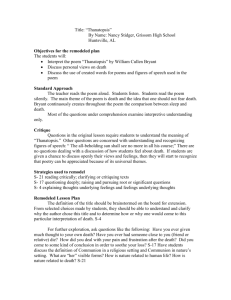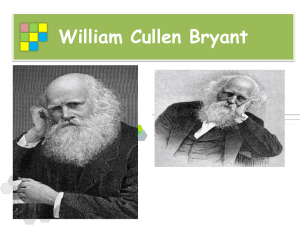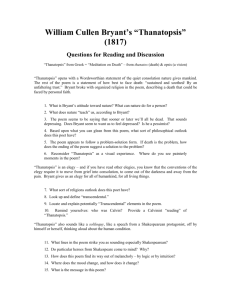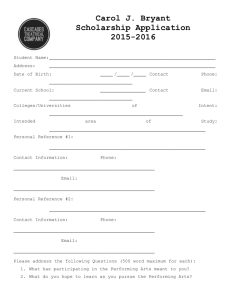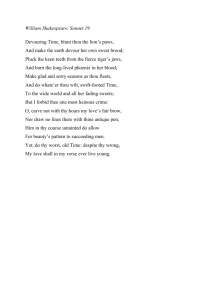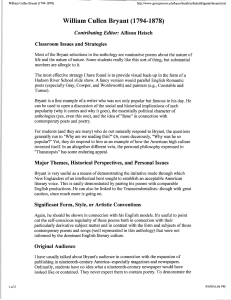Thanatopsis William Cullen Bryant 1794–1878
advertisement
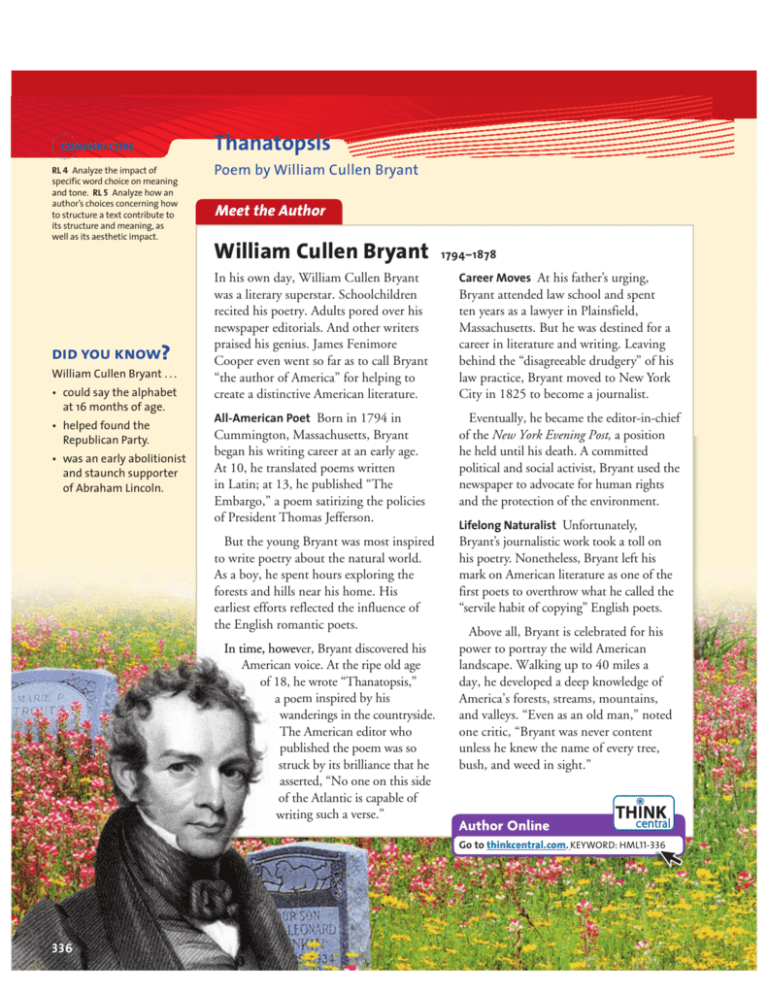
The Early Romantics Thanatopsis RL 4 Analyze the impact of specific word choice on meaning and tone. RL 5 Analyze how an author’s choices concerning how to structure a text contribute to its structure and meaning, as well as its aesthetic impact. did you know? William Cullen Bryant . . . • could say the alphabet at 16 months of age. • helped found the Republican Party. • was an early abolitionist and staunch supporter of Abraham Lincoln. Poem by William Cullen Bryant Meet the Author William Cullen Bryant 1794–1878 In his own day, William Cullen Bryant was a literary superstar. Schoolchildren recited his poetry. Adults pored over his newspaper editorials. And other writers praised his genius. James Fenimore Cooper even went so far as to call Bryant “the author of America” for helping to create a distinctive American literature. Career Moves At his father’s urging, Bryant attended law school and spent ten years as a lawyer in Plainsfield, Massachusetts. But he was destined for a career in literature and writing. Leaving behind the “disagreeable drudgery” of his law practice, Bryant moved to New York City in 1825 to become a journalist. All-American Poet Born in 1794 in Cummington, Massachusetts, Bryant began his writing career at an early age. At 10, he translated poems written in Latin; at 13, he published “The Embargo,” a poem satirizing the policies of President Thomas Jefferson. Eventually, he became the editor-in-chief of the New York Evening Post, a position he held until his death. A committed political and social activist, Bryant used the newspaper to advocate for human rights and the protection of the environment. But the young Bryant was most inspired to write poetry about the natural world. As a boy, he spent hours exploring the forests and hills near his home. His earliest efforts reflected the influence of the English romantic poets. In time, however, howev Bryant discovered his American vvoice. At the ripe old age he wrote “Thanatopsis,” of 18, h poem inspired by his a poe wanderings in the countryside. wan The American editor who published the poem was so pub struck by its brilliance that he struc asserted, “No one on this side asse the Atlantic is capable of of th writing such a verse.” writi Lifelong Naturalist Unfortunately, Bryant’s journalistic work took a toll on his poetry. Nonetheless, Bryant left his mark on American literature as one of the first poets to overthrow what he called the “servile habit of copying” English poets. Above all, Bryant is celebrated for his power to portray the wild American landscape. Walking up to 40 miles a day, he developed a deep knowledge of America’s forests, streams, mountains, and valleys. “Even as an old man,” noted one critic, “Bryant was never content unless he knew the name of every tree, bush, and weed in sight.” Author Online Go to thinkcentral.com. KEYWORD: HML11-336 336 text analysis: blank verse William Cullen Bryant wrote “Thanatopsis” in a verse form known as blank verse. Blank verse is unrhymed poetry written in iambic pentameter. In this meter, each line has five iambic feet, a pattern consisting of an unstressed syllable ( ) followed by a stressed syllable ( ). Poets who write in blank verse sometimes vary this rhythm, using loose iambic pentameter to add a conversational tone. Read the following lines from “Thanatopsis” aloud to hear the rhythm: To him who in the love of Nature holds Communion with her visible forms, she speaks Notice that the first line above uses strict iambic pentameter, while the second is loose, adding a second unstressed syllable in the fourth foot. The effect of this variation is to make the poetry sound much like the way people talk. Bryant also achieves this effect through the use of enjambment, which means that one line ends without a pause and continues into the next line for its meaning. As you read “Thanatopsis,” notice how the poem’s rhythm imitates natural speech. reading skill: understand structure In poetry, structure is the arrangement of words and lines to produce a desired effect. The structure of a poem usually emphasizes important aspects of content and can help a poet indicate shifts in mood. Use the following strategies to help you understand and make inferences about the structure and effects of Bryant’s poem: What can death teach us about life? Some people view death as the ultimate enemy. Others, however, consider it a natural part of life. Acceptance of that fact is a theme of William Cullen Bryant’s “Thanatopsis.” But death—and life—have other important lessons to teach us. One is recognizing that death, since it comes to us all, makes us all equal. What are some other important life lessons? SURVEY With a partner, conduct a survey among your classmates, friends, and family and ask them to name the five greatest lessons that life—or death—has taught them. Compile the results and share them with the rest of the class. • Notice the indented line that indicates the beginning of each of the three verse sections in the poem. • Summarize each section to understand the content and central ideas. • Look for details and word choices that convey mood. As you read “Thanatopsis,” use a chart like the one shown to record the ideas and mood evoked in each section of the poem. Section Ideas Mood 1st Death comes to everyone. bleak 2nd 3rd Complete the activities in your Reader/Writer Notebook. 337 Thanatopsis William Cullen Bryant 5 10 15 20 25 30 35 338 To him who in the love of Nature holds Communion with her visible forms, she speaks A various language; for his gayer hours She has a voice of gladness, and a smile And eloquence of beauty, and she glides Into his darker musings, with a mild And healing sympathy, that steals away Their sharpness, ere he is aware. When thoughts a Of the last bitter hour come like a blight Over thy spirit, and sad images Of the stern agony, and shroud, and pall, And breathless darkness, and the narrow house, Make thee to shudder, and grow sick at heart;— Go forth, under the open sky, and list To Nature’s teachings, while from all around— Earth and her waters, and the depths of air— Comes a still voice—Yet a few days, and thee The all-beholding sun shall see no more In all his course; nor yet in the cold ground, Where thy pale form was laid, with many tears, Nor in the embrace of ocean, shall exist Thy image. Earth, that nourished thee, shall claim Thy growth, to be resolved to earth again, And, lost each human trace, surrendering up Thine individual being, shalt thou go To mix forever with the elements, To be a brother to the insensible rock And to the sluggish clod, which the rude swain Turns with his share, and treads upon. The oak Shall send his roots abroad, and pierce thy mold. b Yet not to thine eternal resting-place Shalt thou retire alone—nor couldst thou wish Couch more magnificent. Thou shalt lie down With patriarchs of the infant world—with kings, The powerful of the earth—the wise, the good, Fair forms, and hoary seers of ages past, All in one mighty sepulcher.—The hills Rock-ribbed and ancient as the sun,—the vales unit 2: american romanticism 2 communion: a close relationship. a BLANK VERSE Reread lines 1–8 aloud. Identify the places where a phrase begins at the end of a line and continues on the next line. How does this enjambment affect the flow of the lines? 11–12 shroud . . . the narrow house: A shroud is a burial garment, while a pall is a heavy garment draped over a coffin. The narrow house is the grave or coffin. 28–29 the sluggish clod . . . share: the heavy mass of earth, which the farmer loosens with his plow. b STRUCTURE What is the central idea of the poem’s first section, lines 1–30? 33 couch: bed. 36 hoary seers: ancient wise men. 37 sepulcher: grave. 40 45 50 55 60 65 70 75 80 Stretching in pensive quietness between; The venerable woods—rivers that move In majesty, and the complaining brooks That make the meadows green; and, poured round all, Old ocean’s gray and melancholy waste,— Are but the solemn decorations all Of the great tomb of man. The golden sun, c The planets, all the infinite host of heaven, Are shining on the sad abodes of death, Through the still lapse of ages. All that tread The globe are but a handful to the tribes That slumber in its bosom.—Take the wings Of morning—and the Barcan desert pierce, Or lose thyself in the continuous woods Where rolls the Oregon, and hears no sound, Save his own dashings—yet—the dead are there; And millions in those solitudes, since first The flight of years began, have laid them down In their last sleep—the dead reign there alone. So shalt thou rest—and what if thou withdraw Unheeded by the living—and no friend Take note of thy departure? All that breathe Will share thy destiny. The gay will laugh When thou art gone, the solemn brood of care Plod on, and each one as before will chase His favorite phantom; yet all these shall leave Their mirth and their employments, and shall come And make their bed with thee. As the long train d Of ages glide away, the sons of men, The youth in life’s green spring, and he who goes In the full strength of years, matron and maid, The speechless babe, and the gray-headed man— Shall one by one be gathered to thy side, By those, who in their turn shall follow them. So live, that when thy summons comes to join The innumerable caravan, which moves To that mysterious realm, where each shall take His chamber in the silent halls of death, Thou go not, like the quarry-slave at night, Scourged to his dungeon, but, sustained and soothed By unfaltering trust, approach thy grave, Like one who wraps the drapery of his couch About him, and lies down to pleasant dreams. e 40 venerable: impressive and worthy of respect because of age. c STRUCTURE Identify the mood in lines 31–45. How does it contrast with the mood in the first section? 51 Barcan desert: a desert region in northern Africa. 53 Oregon: old name for the Columbia River, which flows between the states of Washington and Oregon. d BLANK VERSE Tap your foot to the rhythm as you read lines 61–66. Note the motion described in these lines. How does the rhythm suggest this motion? e STRUCTURE Reread the last section of the poem, lines 73–81. How would you summarize these lines? thanatopsis 339


